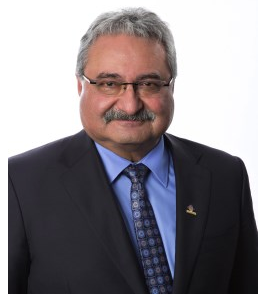MyLloydminsterNow has reached out to the 14 candidates running for the six positions on Lloydminster City Council in the November 13 city-wide elections. Here are the views of Michael Diachuk.
Question 1: Tell me who you are.
Diachuk: I am married with two adult children and have lived in Lloydminster since 1998. I completed my Doctor of Education in 2006 at the University of Alberta. I retired from the Lloydminster Public School Division in 2014 as Director of Education and started my consulting company at that time. In 2015 I joined Lakeland College and worked there as Instructor and then Chair of Teaching and Learning until 2022. I have been on council since 2017.
Question 2: Why do you want to be a city councillor?
Diachuk: I have always believed in giving back and this was one way I could use my knowledge and skills and continue to be a part of the community that has treated my family and me very well over the years.
Question 3: Colleen Young, candidate for the Saskatchewan Party has said, “Our hospital was built for 15,000 people back in 1986 and has not seen significant expansion. Previous ministers of health have recognized the need to expand the hospital to serve patients better. That is another aspect that I would like to see done.”
What are your thoughts on a new or expanded hospital in Lloydminster?
Diachuk: Two studies on the need for hospital services have been completed with a third to begin shortly. The second study is essentially a repeat of the first, and I believe the third study will be hard-pressed to not come up with the same recommendations. One of the administrators in the health region indicated the first two studies were biased, thus the need for the third. It is hard to understand this given they were commissioned by the Saskatchewan government. Given our population has more than doubled since 1986, I believe it will be difficult for the government to deny the need for expansion and enhancement of services for not only our city, but the regions that we serve in Saskatchewan and Alberta. If people want to have a look at comparative data, check out the Canadian Institute for Health Information (www.cihi.ca) to get a sense of how underserved we are compared to other cities our size.
Question 4: What is your plan to deal with homelessness and the unhoused?
Diachuk: This is a complex issue that has evolved from the economic downturn in 2015 to COVID in 2022. We need a wrap-around model to address homelessness in our community. The Home-Based Program out of the Olive Tree has been successful with over 30 people without homes, and transitioning them into housing, and potentially into jobs or appropriate care. We also know that for every dollar we spend on housing, we reduce healthcare costs anywhere from 10 to 13 dollars. Homelessness will not be solved just with housing, but will need supports for addictions and mental illness. Currently, our GIS (plain Clothes) section of the RCMP has established a presence in the section of the city by the Men’s Shelter. Addressing the criminal dimension of homelessness is only one part of it, but perhaps the most concerning to those who live in the community. While council bears the brunt of community concerns, Social Services, Health Care, Addictions and Mental Health all have a role to play in resolving this concern. Part of the problem I have seen in other larger centres is getting all these agencies to work in concert and ensuring they have the human resources and capacity to support the need. Whatever we do, some of the interventions – Home Based Program, and added police presence are short-term interventions. We need more intermediate steps such as Transitional Housing, Mental Health, and Addictions support to move people into a long-term solution in permanent housing with supports as needed. This challenge has been developing since 2015 and we are eight years into this growing challenge. It will take perhaps as many years to sort it out and provide the appropriate supports needed.
Question 5: What are your thoughts on dealing with crime and insecurity?
Diachuk: There is a reason why we have the ALERT team from Alberta, and Guns and Gangs from Saskatchewan here in our city. Our city has one of the major arteries connecting provinces in our country. Creating a safe community is one of the top priorities if not the top priority for our Council. Adding more RCMP comes at a cost and while it may assist in managing the crime rate other variables have a significant influence on the types of crimes and their rates. For example, when we review crime statistics provided by the RCMP we see various patterns. When the economy took a downturn, we saw a spike in domestic violence and theft. When the economy is doing very well, we see other crime rates spike as it relates to drug trafficking and gang-related activity. In addition, cycles are often connected to individuals who are incarcerated and then released. Rates go down when they are serving time and spike up after their release.
Most concerning now is the sense that residents don’t feel safe walking downtown. The presence of GIS getting to know who the homeless people are and identifying those that are doing the crime, is part of creating a safer community for the neighbourhood as well as the homeless who are also vulnerable to the criminal element. A police presence in high crime rate areas is essential as well, as not only must we doing something to address crime, but also be perceived to be doing something about the crime. For example, we know that using our photo radar has an effect on speed control by its very presence. When we see a police presence in our community criminals will certainly think twice about committing the crime given the likelihood of being caught.
Question 6: Final thoughts
Diachuk: We are a growing city that is on track for significant economic and population growth in the decade ahead. We have our challenges as all cities do. While we experience these challenges it can cloud our view of the city and the many great assets we have. Comments shared by visitors at our Summer Games as well as those from family who visit or drive through the city, comment on how well the city is kept, how clean it is, and how fortunate we are to have the many services we do have. Making a city successful takes the effort of all of us who live in this city, not just the police, emergency services, or the city staff and council. We all own it and need to invest our time and efforts in it to make it a successful, safe, and prosperous place to make a home and raise a family.



